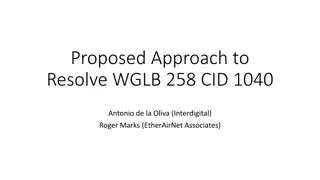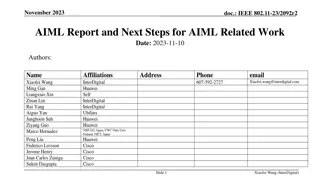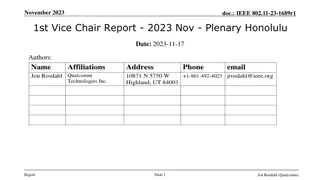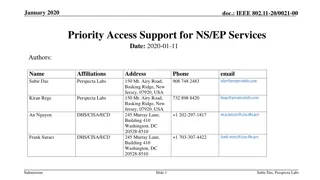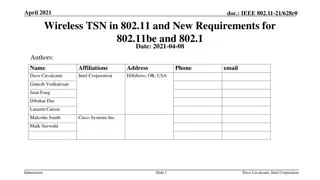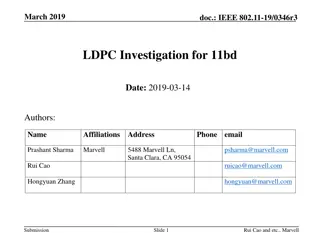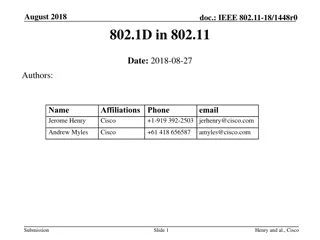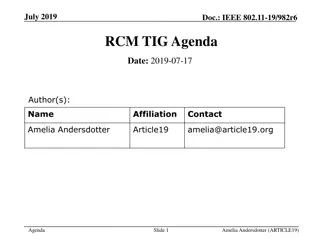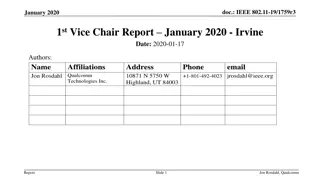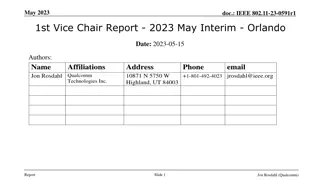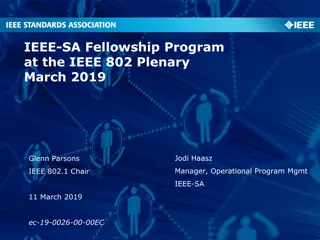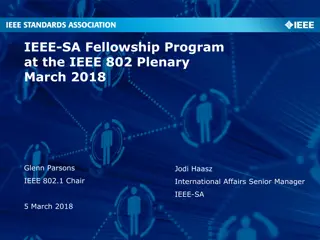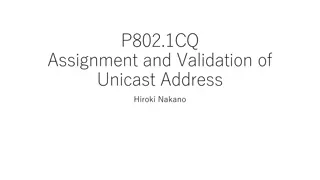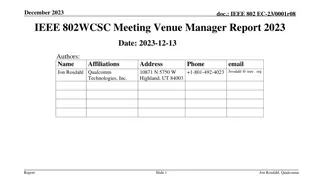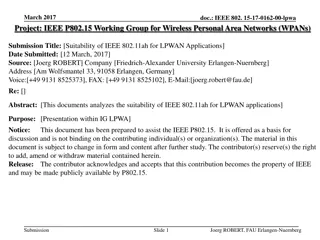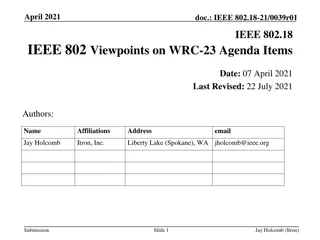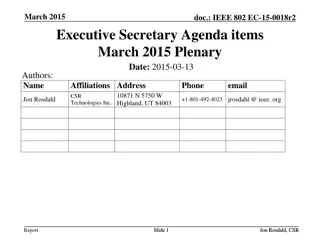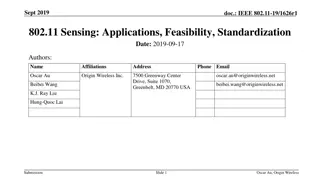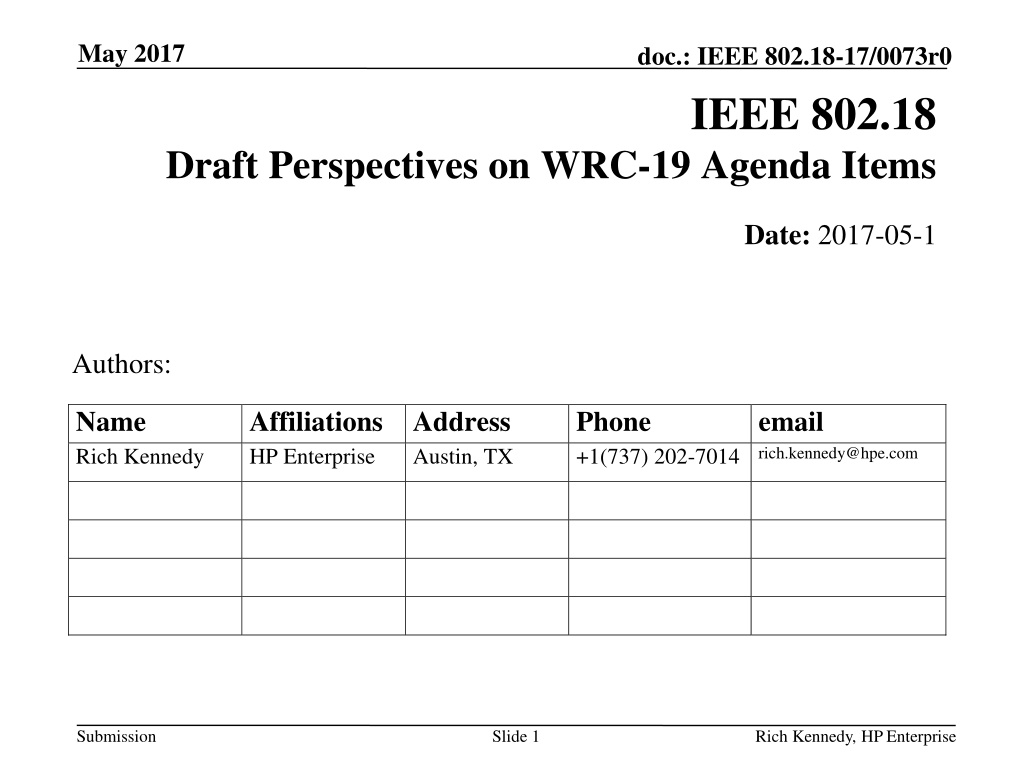
IEEE 802 Standards and WRC-19 Agenda Items Overview
Gain insights into IEEE 802 standards' perspectives on WRC-19 agenda items, including ITS harmonization, IMT frequency bands, and HAPS regulatory actions. Explore the draft viewpoints presented by Rich Kennedy from HP Enterprise.
Download Presentation

Please find below an Image/Link to download the presentation.
The content on the website is provided AS IS for your information and personal use only. It may not be sold, licensed, or shared on other websites without obtaining consent from the author. If you encounter any issues during the download, it is possible that the publisher has removed the file from their server.
You are allowed to download the files provided on this website for personal or commercial use, subject to the condition that they are used lawfully. All files are the property of their respective owners.
The content on the website is provided AS IS for your information and personal use only. It may not be sold, licensed, or shared on other websites without obtaining consent from the author.
E N D
Presentation Transcript
May 2017 doc.: IEEE 802.18-17/0073r0 IEEE 802.18 Draft Perspectives on WRC-19 Agenda Items Date: 2017-05-1 Authors: Name Rich Kennedy Affiliations Address HP Enterprise Phone +1(737) 202-7014 rich.kennedy@hpe.com email Austin, TX Submission Slide 1 Rich Kennedy, HP Enterprise
May 2017 doc.: IEEE 802.18-17/0073r0 Introduction IEEE 802 has been asked by some developing country regulators for our position on certain WRC-19 Agenda Items This document provides initial draft viewpoints for the agenda items that relate to IEEE 802 standards Submission Slide 2 Rich Kennedy, HP Enterprise
doc.: IEEE 802.18-17/0073r0 AI 1.12 ITS Harmonization to consider possible global or regional harmonized frequency bands, to the maximum extent possible, for the implementation of evolving Intelligent Transport Systems (ITS) under existing mobile-service allocations, in accordance with Resolution COM6/13 (WRC-15); IEEE 802.11 has provided the wireless standard (IEEE Std 802.11p-2010) that is the basis for much of the Intelligent Transport Systems (ITS) Vehicle-to-Vehicle (V2V) and Vehicle-to-Infrastructure (V2I) technologies. We believe that this technology, that is successful because of its spectrum sharing mechanisms, is capable of sharing the 5850- 5925 MHz band with other unlicensed applications. We also understand that global harmonization of the technology is a noble effort that would enable technology improvements and cost reductions to better address rapid adoption to meet the ITS safety goals. Submission
doc.: IEEE 802.18-17/0073r0 AI 1.13 IMT to consider identification of frequency bands for the future development of International Mobile Telecommunications (IMT), including possible additional allocations to the mobile service on a primary basis, in accordance with Resolution COM6/20 (WRC-15); IEEE 802 believes that WRC19 should consider possible identification of a number of bands including 66-76 GHz for IMT. On July 14, 2016, FCC published a Report and Order and Further Notice of Proposed Rulemaking (FCC 16-89) to adopt 64- 71 GHz band for License Exempt operation, and we believe that IMT will benefit from global harmonization of these bands. Submission
doc.: IEEE 802.18-17/0073r0 AI 1.14 HAPS to consider, on the basis of ITU-R studies in accordance with Resolution COM6/21 (WRC-15), appropriate regulatory actions for high-altitude platform stations (HAPS), within existing fixed-service allocations; IEEE 802 has no position on this technology as it is not based on any 802 standards. Submission
doc.: IEEE 802.18-17/0073r0 AI 1.15 275 GHz to consider identification of frequency bands for use by administrations for the land- mobile and fixed services applications operating in the frequency range 275-450 GHz, in accordance with Resolution COM6/14 (WRC-15); IEEE P802.15.3d is a draft standard, currently in the balloting process and expected to be published in the beginning of 2018. This new standard will target point-to-point links in the frequency range of 252 to 325 GHz with data rates ranging from 1 to 100 Gb/s. The application scenarios comprise wireless back-/fronthaul links, kiosk downloading, reconfigurable wireless links for data centers in addition to fibers and intra-device communications. Therefore, IEEE 802 especially supports the identification of the frequency bands 275 GHz to 325 GHz for active services such as THz communications. Higher frequency bands beyond 325 GHz, e. g. up to 450 GHz, are highly appreciated for future wireless communication applications. No activity toward a new standard at these higher frequencies has been formed yet, because the technology at 300 GHz seemed most promising in 2014 when the project for the first standard in the THz range was initiated. However this may change in the future. Submission
doc.: IEEE 802.18-17/0073r0 AI 1.16 5 GHz to consider issues related to wireless access systems, including radio local area networks (WAS/RLAN), in the frequency bands between 5 150 MHz and 5 925 MHz, and take the appropriate regulatory actions, including additional spectrum allocations to the mobile service, in accordance with Resolution COM6/22 (WRC-15); Since the 1990s, IEEE 802 has been actively developing standards for Wireless LAN technologies that operate in the 5 GHz bands. Among these is 802.11, which is the standard that has become known as Wi-Fi, which is the most successful, most used and most demanded wireless technology. Carrying the vast majority of wireless internet traffic, IEEE 802.11 is essential for commercial services, education, communications and social interactions. It has created whole industries and provided jobs and economic growth around the world. IEEE 802 believes that any regulatory actions should not disadvantage Wi-Fi, or add any additional regulatory burdens for its use of the 5 GHz bands. Submission
doc.: IEEE 802.18-17/0073r0 AI 9.1 Issue 9.1.5 to investigate the technical and regulatory impacts on the services referred to in Nos. 5.447F and 5.450A that would result from referencing Recommendation ITU-R M.1638- 1 in place of Recommendation ITU-R M.1638-0 in those footnotes, while ensuring that no undue constraints are imposed on the services referenced in these footnotes; to investigate the technical and regulatory impacts on the services referred to in Nos 5.447F and 5.450A that would result from adding a new reference to Recommendation ITU-R M.1849-1 to these footnotes, while ensuring that no undue constraints are imposed on the services referenced in these footnotes, The revised versions of both ITU-R M.1638 and M.1849 include additional radars that have never been evaluated for their effect on the operation of 802.11 standards-based products in the U-NII-2a and U-NII-3 bands. These include bi-static (transmitter and receiver not co-located) and fast frequency hopping radars that offer little opportunity to be detected and avoided by 802.11 devices, and threaten the viability of this vital technology in these bands, which represent 355 MHz of the 580 MHz of spectrum available in the band; over 60 % of the available channels. IEEE 802 believes this must be studied carefully before allowing this change in references. Submission

